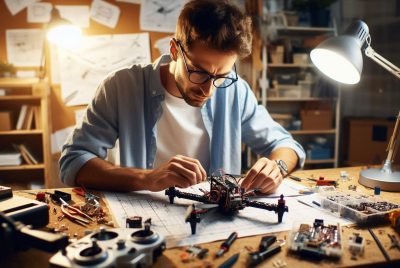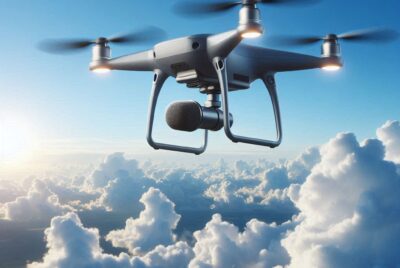Drone Repair Demystified: Essential Tips and Tricks
*We may earn a commission for purchases made using our links. Please see our disclosure to learn more.
Drone Repair Essentials: A Comprehensive Guide to Fixing Your UAV
Drones, also known as unmanned aerial vehicles, have become ubiquitous in both recreational and commercial industries. As a drone enthusiast and a professional in the field, I understand how crucial it is to maintain these sophisticated pieces of technology with drone repair. Over time, drones can suffer from wear and tear or unexpected damage, leading to the need for repairs. My experience has taught me that prompt and proper fixes not only ensure the longevity of the drone but also maintain the safety of the operations they’re involved in.

Repairing drones is a detailed process that requires technical expertise. I’ve encountered various types of malfunctions, ranging from simple propeller replacements to more intricate issues like camera or sensor malfunctions. Engaging with certified service centers that specialize in drone repair is paramount, as they provide access to genuine parts and highly skilled technicians trained specifically for the job. Knowledge about different brands and their service offerings is beneficial. For example, DJI offers dedicated repair and replacement service plans, enhancing the customer experience and ensuring reliability.
Understanding Drone Technology

In discussing drone technology, I will focus on different types of drones and their components which are essential for understanding repairs.
Types of Drones
Consumer Drones: These are primarily used for photography and recreational purposes. Notable examples include DJI’s Phantom series, a line of quadcopters known for their stability and high-quality imaging capabilities.
Civilian UAVs: Specifically designed for commercial use, they range from small, lightweight models to larger drones capable of carrying heavier payloads for agriculture, surveying, and other industries.
FPV Drones: Short for First Person View, these drones are equipped with cameras that provide a live video feed to the pilot on the ground, often used for racing and immersive flying experiences.
Drone Components
- Frame: The structural base of a drone, usually a lightweight and resilient composition suitable for airborne applications.
- Motors and Propellers: Provide the necessary lift. Drones such as quadcopters typically have four motors and propellers.
- Battery: Powers the drone, most commonly a rechargeable lithium-polymer (LiPo) type.
- Flight Controller: The ‘brain’ of the drone, which controls the motors’ speed and the drone’s stability. Models like the DJI Phantom integrate advanced flight controllers for precise flying.
- Sensors/GPS: Allow the drone to measure its position and altitude, crucial for stability and navigation.
- Camera/Gimbal: Drones often carry cameras for photography and video, stabilized by a gimbal to prevent shaky footage, a feature particularly significant in FPV drones.
- Transmitter/Receiver: Used to control the drone and receive data, with FPV systems requiring specialized transmitters for video streaming.
Understanding these fundamental aspects is vital for drone repair and maintenance, as it helps identify common issues and solutions.
Drone Maintenance

In my experience, the key to keeping drones in top condition lies in two main practices: consistent preventative measures and thorough routine inspections. This not only ensures safe and reliable operation but can significantly extend the service life of the drone.
Preventative Measures
Firmware Updates:
- I regularly check and install the latest firmware updates for my drone. This is crucial for fixing bugs, improving functionality, and enhancing safety features.
Battery Care:
- I store my drone batteries in a cool, dry place and avoid depleting them completely before recharging. Charging and discharging batteries correctly prevents wear and boosts longevity.
- Always use the correct charger and follow the manufacturer’s guidelines.
Environmental Considerations:
- Prior to each flight, I ensure the drone is clean and free from debris. Dust and dirt can cause overheating and impair sensor function.
Routine Inspection
Physical Check:
- Before and after flights, I meticulously inspect the propellers, motors, and frame for any signs of damage or wear.
Functional Testing:
- I perform pre-flight checks to verify all controls are responsive and the drone’s movements are stable.
Flight Logs Review:
- I maintain a detailed log of all flight times, distances, and any incidents to track the health of my drone and identify when maintenance is needed.
Common Drone Repairs
In my experience with drone maintenance, certain issues come up more frequently than others. Knowing how to address these common problems effectively is crucial for any drone operator. Here’s how I deal with the most typical repairs.
Propeller Damage
Damaged propellers are a common result of crashes or rough landings. To ensure optimal performance, I check for cracks, chips, and bends on the propeller blades. In case of visible damage, I replace the propellers, following these steps:
- Remove the damaged propeller: Using a propeller removal tool, I gently detach the propeller from the motor.
- Install a new propeller: Making sure to match the correct propeller type to the motor, I press it on gently until it snaps into place.
Battery Issues
Battery problems often stem from improper usage or charging practices. If the drone experiences reduced flight time, I:
- Inspect the battery: I check for bloating, leakage, or damage. If any of these signs are present, the battery is replaced.
- Perform calibration: Occasionally, calibrating the battery through the drone’s settings can restore its efficiency.
Motor Dysfunction
A malfunctioning motor can be due to a collision or wear and tear. When a motor issue arises, I take the following approach:
- Check for obstructions: I look for and remove any debris that might be hampering motor rotation.
- Test motor connectivity: Using a multimeter, I test the motor’s connections to ensure proper electrical flow. If the motor is unresponsive and visibly undamaged, it may need to be resoldered or replaced.
By thoroughly inspecting and methodically addressing these common issues, I maintain my drone’s performance and extend its operational lifespan.
Drone Repair Process and Cost

When it comes to drone repair, I understand that accuracy in diagnosing issues and clarity in estimating repair costs are paramount. It’s crucial to grasp these elements to ensure repairs are both effective and economical.
Diagnosing Issues
To begin with, I meticulously inspect the drone to identify the faults. For complex problems, I might utilize advanced diagnostic tools like multimeters or oscilloscopes to pinpoint electrical issues. Drones like the Phantom 4 Pro require specific attention to their sophisticated components, such as the gimbal and camera systems, which, if damaged, drastically affect the performance and repair process.
Estimating Repair Costs
In terms of estimating repair costs, I consider several factors:
- Parts: The cost of replacement parts.
- Labor: Rates are typically charged per hour. For instance, DJI charges about $65 per hour.
- Model: Some models, such as the aforementioned Phantom drone, may incur higher costs due to their complex systems.
The repair service quotation is structured as follows:
| Repair Component | Estimated Cost |
| Gimbal and Camera Repair | $699 (Phantom 4 Pro) |
| Main Control Board | $261 (Phantom 4 Pro) |
| Labor (Per Hour) | $65 |
I rely on my experience to provide a reliable quote, considering both part prices and labor hours needed. If additional damage is discovered during repair, I update the cost estimate and communicate promptly. Repairing higher-end models like the Phantom 4 Pro is typically more costly than entry-level models, due to the parts’ sophistication and experience required for such intricate work.
Choosing a Drone Repair Service

When my drone requires repair, I give top priority to the service center’s expertise and the certifications the technicians hold. It’s crucial for me to trust in their ability to handle and fix my equipment with the utmost care.
Evaluating Expertise
Experience: I look for repair services that have a substantial track record, with particular emphasis on their work with drones similar to mine. For example, if I own a DJI drone, I want a service center that has a strong background in handling DJI models.
- Reputation: The service’s reputation is discerned through customer feedback and reviews. I scrutinize these insights carefully, checking platforms such as online forums, social media, and drone enthusiast groups for a consensus on the service quality.
Certifications
- DJI Certification: As many drone owners use DJI models, I verify that the technicians are DJI certified. This ensures that they are up-to-date with the latest DJI drone technology and repair methodologies.
- Industry Recognized Certifications: Beyond brand-specific qualifications, I look for any industry-recognized certifications that validate a technician’s skills and knowledge in electronics and drone repair.
FAQs About Drone Repair
In my experience as a drone enthusiast and expert, I have come across a variety of questions regarding drone repair. Here are comprehensive answers to some of the most frequently asked questions that should cover the essentials if you’re facing drone issues.
1. What are common issues that require drone repair?
Many drones come in for repairs due to battery failures, motor issues, or damage from crashes such as broken propellers and frames. Firmware problems can also arise, necessitating a repair or an update.
2. Where can I find authorized repair services for my DJI drone?
Authorized DJI repair services can be located through the official DJI website. These centers are certified to handle repairs and are knowledgeable about DJI drone models.
3. How much does it typically cost to repair a drone?
Repair costs vary widely depending on the drone’s model and the extent of the damage. Minor repairs might be under $100, but more extensive damage could entail costs of several hundreds of dollars.
4. Is it possible to get my drone repaired at electronics retail stores?
Some electronics retail stores provide repair services for drones. However, I advise checking if they are authorized to repair your specific drone model to ensure quality service.
5. How do I ensure the safety of my drone during the repair process?
To ensure the safety of my drone during the repair process, I disconnect the battery, remove the propellers, and choose a reliable and certified repair center. Good documentation of the drone’s condition before sending it for repair is also prudent.




